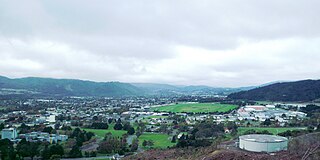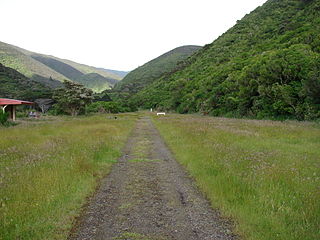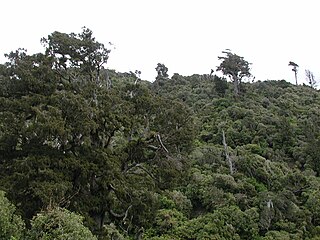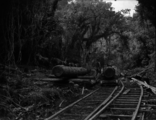
Upper Hutt is a city in the Wellington Region of New Zealand and one of the four cities that constitute the Wellington metropolitan area.

Kaitoke, part of Upper Hutt City, is a locality in the southern North Island of New Zealand. It is located at the northern end of the Hutt Valley, 45 kilometres northeast of Wellington City and six kilometres from the northern end of the Upper Hutt urban area. It also lies at the southern end of the Tararua Ranges.

The Rimutaka Incline was a 3-mile-long (4.8 km), 3 ft 6 in gauge railway line on an average grade of 1-in-15 using the Fell system between Summit and Cross Creek stations on the Wairarapa side of the original Wairarapa Line in the Wairarapa district of New Zealand. The term "Rimutaka Incline" is sometimes used incorrectly to refer to other parts or all of the closed and deviated section of the Wairarapa Line between Upper Hutt and Speedy's Crossing, near Featherston. The incline formation is now part of the Remutaka Rail Trail.

The Fell system was the first third-rail system for railways that were too steep to be worked by adhesion on the two running rails alone. It used a raised centre rail between the two running rails to provide extra traction and braking, or braking alone. Trains were propelled by wheels horizontally applied and retracted by springs onto the centre rail, controlled from the cab, as well as by the normal running wheels. In practice, the running wheels could be allowed to run freely to reduce wear, but the centre brake shoes needed to be replaced frequently. For example: the locomotives' shoes were replaced after each journey on the Mont Cenis Pass Railway. Extra brake shoes were fitted to specially designed or adapted Fell locomotives and brake vans, and for traction the prototype locomotive had an auxiliary engine powering the horizontal wheels. The Fell system was developed in the 1860s and was soon superseded by various types of rack railway for new lines, but some Fell systems remained in use into the 1960s. The Snaefell Mountain Railway still uses the Fell system for (emergency) braking, but not for traction.

The Remutaka Range is the southernmost range of a mountain chain in the lower North Island of New Zealand. The chain continues north into the Tararua, then Ruahine Ranges, running parallel with the east coast between Wellington and East Cape.

John Barraclough Fell was an English railway engineer and inventor of the Fell mountain railway system.

The NZR H class steam locomotive was a unique class of Fell locomotive used by New Zealand Railways (NZR) on the Rimutaka Incline, the 3-mile (4.8 km) section of 1 in 15 gradient between Cross Creek and Summit, over the Rimutaka Ranges.

The Wairarapa Line is a secondary railway line in the south-east of the North Island of New Zealand. The line runs for 172 kilometres (107 mi), connects the capital city Wellington with the Palmerston North - Gisborne Line at Woodville, via Lower Hutt, Upper Hutt and Masterton.
Birchville is a suburb of Upper Hutt, New Zealand in the North Island. Its centre lies at the entrance to the Akatarawa Valley, in the north of the city, near confluence of the Akatarawa River with the Hutt River. It is about a 5 km (10-minute) drive north from the centre of Upper Hutt. The Birchville community is spread out along both banks of the Hutt River in a long fairly narrow valley.

The Fell Locomotive Museum in Featherston, New Zealand, exhibits the only remaining steam-powered Fell railway locomotive in the world.

Ngauranga railway station is a single island platform railway station in the mainly industrial and commercial suburb of Ngauranga on the Wairarapa Line in Wellington, New Zealand. It is on the Wellington suburban rail network and is served by Melling Line trains and some only Hutt Valley Line trains. Wairarapa Connection trains pass this station but do not stop. All trains are run by Transdev as part of the Metlink network.
The Rimutaka Incline Railway Heritage Trust is a non-profit, charitable trust in New Zealand that was established in 2003 with the objective of reinstating an operating heritage railway over the Remutaka Ranges using the original route of the Wairarapa Line between Maymorn and Featherston, including the world-famous Rimutaka Incline.

Mangaroa railway station was a single-platform rural railway station on the Wairarapa Line between Upper Hutt and Featherston in the Wellington region of New Zealand’s North Island, on the section that was replaced by the Rimutaka Tunnel deviation in 1955. It served the small rural settlement of Mangaroa, in the Mangaroa Valley, east of Upper Hutt.

Cross Creek railway station was the base of operations for the Rimutaka Incline, a Fell railway over the Remutaka Ranges, and part of the original Wairarapa Line between Upper Hutt and Featherston in the Wellington region of New Zealand's North Island. The station was between Pigeon Bush and Summit stations on the Wairarapa Line. The station was bypassed when the Rimutaka Tunnel was opened.

The Powelltown tramway was a 3 ft narrow gauge tramway that operated between Powelltown and Yarra Junction, Victoria, Australia, between 1913 and 1945.
The Petone Workshops were a government-owned railways maintenance and repair facility located in Petone, in Lower Hutt in the Wellington region of New Zealand's North Island. It took over construction and maintenance of rolling stock in the Wellington region from the Pipitea Point facility, starting in 1876, and became the only such facility in the region from 1878 until the opening of the replacement Hutt Workshops facility in 1929.
The Rimutaka incline railway line suffered from strong cross winds. On two occasions passenger trains were derailed by them. The first in 1880 resulting in four deaths, and the second in 1936 resulting in only injuries.

The May Morn Estates Tramway was a bush tramway at Mangaroa, which crossed the Hutt River at Te Mārua near Upper Hutt on New Zealand's North Island. The company was incorporated in 1912 and operated their saw mill at least from 1914 to 1915.

The Charming Creek Tramway was a 9 kilometres (5.6 mi) long private bush tramway at Ngakawau in Buller District on the West Coast in New Zealand. It was used from 1903 or 1905 to 1958.

Pakuratahi Forest is a regional park located in Upper Hutt in the Wellington Region at the southern end of New Zealand's North Island. It is administered by Wellington Regional Council.



















